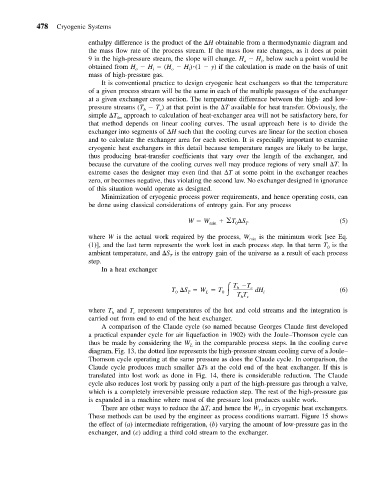Page 489 - Mechanical Engineers' Handbook (Volume 4)
P. 489
478 Cryogenic Systems
enthalpy difference is the product of the H obtainable from a thermodynamic diagram and
the mass flow rate of the process stream. If the mass flow rate changes, as it does at point
H , below such a point would be
i
9 in the high-pressure stream, the slope will change. H o
H (H H ) (1 y) if the calculation is made on the basis of unit
obtained from H o i o i
mass of high-pressure gas.
It is conventional practice to design cryogenic heat exchangers so that the temperature
of a given process stream will be the same in each of the multiple passages of the exchanger
at a given exchanger cross section. The temperature difference between the high- and low-
T ) at that point is the T available for heat transfer. Obviously, the
pressure streams (T h c
simple T approach to calculation of heat-exchanger area will not be satisfactory here, for
lm
that method depends on linear cooling curves. The usual approach here is to divide the
exchanger into segments of H such that the cooling curves are linear for the section chosen
and to calculate the exchanger area for each section. It is especially important to examine
cryogenic heat exchangers in this detail because temperature ranges are likely to be large,
thus producing heat-transfer coefficients that vary over the length of the exchanger, and
because the curvature of the cooling curves well may produce regions of very small T.In
extreme cases the designer may even find that T at some point in the exchanger reaches
zero, or becomes negative, thus violating the second law. No exchanger designed in ignorance
of this situation would operate as designed.
Minimization of cryogenic process power requirements, and hence operating costs, can
be done using classical considerations of entropy gain. For any process
W W T S (5)
min 0 T
where W is the actual work required by the process, W min is the minimum work [see Eq.
is the
(1)], and the last term represents the work lost in each process step. In that term T 0
ambient temperature, and S is the entropy gain of the universe as a result of each process
T
step.
In a heat exchanger
T S W T T T c
h
0
0
T
L
TT dH i (6)
hc
where T and T represent temperatures of the hot and cold streams and the integration is
c
h
carried out from end to end of the heat exchanger.
A comparison of the Claude cycle (so named because Georges Claude first developed
a practical expander cycle for air liquefaction in 1902) with the Joule–Thomson cycle can
in the comparable process steps. In the cooling curve
thus be made by considering the W L
diagram, Fig. 13, the dotted line represents the high-pressure stream cooling curve of a Joule–
Thomson cycle operating at the same pressure as does the Claude cycle. In comparison, the
Claude cycle produces much smaller Ts at the cold end of the heat exchanger. If this is
translated into lost work as done in Fig. 14, there is considerable reduction. The Claude
cycle also reduces lost work by passing only a part of the high-pressure gas through a valve,
which is a completely irreversible pressure reduction step. The rest of the high-pressure gas
is expanded in a machine where most of the pressure lost produces usable work.
There are other ways to reduce the T, and hence the W , in cryogenic heat exchangers.
L
These methods can be used by the engineer as process conditions warrant. Figure 15 shows
the effect of (a) intermediate refrigeration, (b) varying the amount of low-pressure gas in the
exchanger, and (c) adding a third cold stream to the exchanger.

